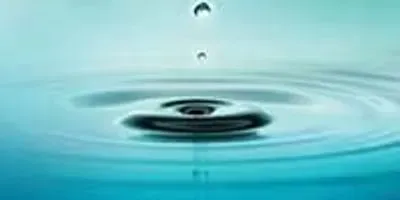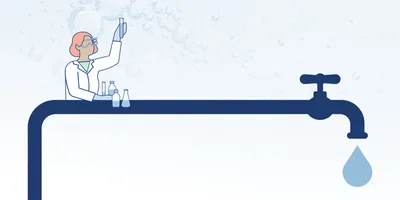
According to an analysis published in 2012 by an architectural and engineering firm that specializes in lab design, a laboratory will consume five times more energy and water per square foot than a similarly sized office building.1 Harvard University, for example, has found that while laboratories occupy 20 percent of its physical property, they are consuming 44 percent of the total energy used.2
Water is a commonly used reagent in the laboratory, and its quality is of paramount importance, as impurities may compromise experimental results. For this reason, water purification systems, either centralized or localized, are among the most common pieces of equipment found in a laboratory facility.
The choices made in selecting a water purification system can have an impact on the environmental footprint of an organization or facility. The environmental impact can become meaningful when the total number of systems that are in operation in a lab, in a building, or across the entire organization are taken into consideration. However, many solutions exist that can mitigate or minimize this environmental impact. In addition to reducing waste of resources, there is an economic benefit in behaving in a more sustainable manner, and absolute costs can be quantified for a lab or a department. Additionally, many organizations also have individual and departmental mandates to contribute to the conservation of resources and/or the reduction of their environmental footprint.
Environmental impact of purification technologies
 Figure 1. Schematics of a water purification system.Water may be purified by distillation, deionization, reverse osmosis, or using water purification systems combining several purification technologies. (Figure 1)
Figure 1. Schematics of a water purification system.Water may be purified by distillation, deionization, reverse osmosis, or using water purification systems combining several purification technologies. (Figure 1)
Distillation
Water distillation is one of the oldest and most commonly used purification techniques. It entails heating the water, usually with electricity, and then condensing the vapors obtained, usually by cooling with tap water.
One three-liter-per-hour distillation consumes almost five kilowatt hours of electricity; thus, one hour of distillation uses as much electricity as using a hair dryer for ten minutes every day for a month or running a coffee machine for an entire month. In addition, nine liters of water are consumed for every liter of purified water produced (11 percent recovery). In a laboratory using 20 liters per day of distilled water, the still will consume almost 45,000 liters of water in one year, which is the amount of water needed to fill a regulation-size professional ice hockey rink.3
Reverse osmosis
In reverse osmosis (RO), pressure is applied to the water, forcing it through a semipermeable membrane. Pure water passes through the membrane, while water impurities remain on the other side of the membrane.
Depending on the design, most RO systems will reject upwards of 50 to 80 percent of feed water, which is sent directly to the drain. In larger RO-based systems that service whole buildings, the amount of water wasted can become quite substantial. Larger 100-L/hour systems can consume 200 to 500 liters of water per hour, whereas smaller 24-L/hour systems can consume 48 to 120 liters of water per hour.
Another environmental consideration is that RO is a temperature-dependent process, which means that for every degree Celsius drop in temperature, the flow rate through the RO membrane decreases by three percent. A ten-degree decrease in water temperature between summer and winter, for example, will result in a 30 percent decrease in efficacy of the water system. Many manufacturers will combat this challenge by adding a booster pump to ensure efficient flow; however, these pumps consume more electricity and actually waste more water. Other manufacturers may oversize the RO system to account for the lowest flow rate that can be expected throughout the year. In warmer months, however, the consumption will increase, and once again more water will be wasted.
Advanced Lab Management Certificate
The Advanced Lab Management certificate is more than training—it’s a professional advantage.
Gain critical skills and IACET-approved CEUs that make a measurable difference.
Many centralized RO and RO DI (deionized) systems operate on a distribution loop, which means that the water is generated in one location, pumped to all the lab locations, and then returned to a central collection tank. This pump is constantly recirculating, resulting in additional electrical consumption. The size of the pump required for effective distribution—and the resulting amount of electricity also needed—are dependent on the size of the facility.
Ultrafiltration
This purification technique is used to remove both endotoxins and nucleases. It relies on a membrane functioning as a molecular sieve.
Typically, water purification systems come with optional internal ultrafilters, which work like reverse osmosis in that these filters employ a tangential flow scheme. Up to 25 percent of the ultrapure water that is flushed through this filter, or 500 mL for every 1.5 L produced, will be sent to the drain as part of this ultrafiltration/purification step.
Magnifying this waste potential is the fact that the water going through the ultrafilter is already ultrapure. Approximately 25 percent of the water that has already been purified is therefore wasted, which drives up the cost of consumables, as more frequent cartridge exchange is needed. In total, a life science lab using approximately ten liters of water a day from an ultrapure water system that has a built-in ultrafilter could be wasting at least three liters of water every single day.
Additional considerations
There are additional environmental considerations, including UV lamps, pumps, and cartridges and filters, to keep in mind when purifying lab water. Current UV technology utilizes mercury to generate radiation, and mercury waste handling should therefore be taken into consideration when building a water purification system. Some complete water purification installations may have up to four UV lamps in their system. Mercury must be disposed of in accordance with the facility’s mercury policies or placed in the same containers/waste stream as fluorescent bulbs.
In water purification systems, pumps drive most of the water. Booster pumps, distribution pumps, and polisher recirculation pumps all vary in their electrical consumption. In many cases, these pumps consume electricity all the time, even when the purification system is not being used, because they must continuously recirculate or distribute the water.
Water purification systems also utilize consumable products, including filters and ultrapure purification cartridges, that can significantly contribute to laboratory waste. Some organizations may generate tons of waste products that end up in a landfill or an incinerator. Unfortunately, many of these waste products are plastics and resins that take a significant amount of time to ultimately decompose. Additionally, many of these products are one-time-use materials, virgin plastics and virgin resins, resulting in a considerable waste stream.
Finally, every purification process has reject streams or condensation streams where water is being sent to the drain. Some water purification systems are designed to flush or purge up to 20 liters of water a day directly from the system to ensure that it is clean of microbial contamination. When all these sources are summed up, the waste may be hundreds of liters a month, and sometimes this waste is ultrapure water that is being sent down the drain.
Selecting sustainable solutions
Improvements have been made to commercially available technologies to reduce the environmental impact of purifying water. Some of these alternatives completely change the purification technologies, whereas others simply optimize existing techniques (Table 1). Selecting the most appropriate water purification system, as well as observing sustainable practices, will have significant impact on the lab's overall environmental footprint.
| RO-EDI V's Distillation | Reverse Osmosis: water-saving techniques | Ultrafiltration: technical improvements |
| Consumes 1/10 of the electricity of similarly-sized stills | Reject-stages RO modules | Zero-reject ultrafilters available at the point-of-use |
| Uses about 40% less water than similarly-sized stills | RO recovery loops | UV and purification media optimization |
| Realize significant savings as an operating | Temperature controlled booster pumps: constant flow | Reduced need to flush liters of water daily prior to use |
| Optimized feed and RO control can result in up to 80% recovery |
Replacing distillation with reverse osmosis and electrodeionization
Choosing a combination of reverse osmosis and electrodeionization (EDI) over distillation would considerably improve the environmental footprint of a laboratory, as it uses significantly less electricity and water than similarly sized stills.3
New generation of reverse osmosis
There have been several technical improvements in reverse osmosis over the past 20 to 30 years that are designed to send less water down the drain. For example, a relatively new technology called E.R.A.™, or Evolutive Reject Adjustment, completely flips the waste paradigm in RO systems, moving from 20 percent recovery to 80 percent recovery with tap water sources that are well managed and well maintained prior to going to the reverse osmosis step.
Ultrafiltration at the point of use
In ultrafiltration, simply moving from an internal inline ultrafilter, which has a built-in reject flow, to a point-of-use filter that processes 100 percent of the ultrapure water will save about half a liter for every two liters that are processed. These savings can quickly multiply, based on the volumes of water that are produced every day.
Recycling and other sustainable practices
As facilities are developed or renovated, a gray water recovery system should be considered where feasible. As these systems are typically tap water driven, the quality is very good for typical gray water uses, including flushing toilets or irrigating the grass or plants at a particular site. Organizations should also select manufacturers that are actively engaged in sustainability practices, and systems, packaging, and water purification cartridges should be recycled where supported by organizational policy. For example, in one manufacturer's existing U.S. program for spent water purification cartridges, a life cycle assessment showed that collection and recycling of these cartridges could reduce their environmental impact by ten to 15 percent.
Customers are able to send their used cartridges to a specialized waste management company for recycling, thus avoiding landfill dumping or incineration.4 And finally, the water system should be sized according to usage and application.
Conclusion
Water is an important resource, not only in the everyday world but also in the laboratory. Well-designed water purification systems using the proper combination of purification technologies will ensure that the water produced is suitable for the specific applications for which it is needed. Choosing more sustainable water purification technologies and solutions will ensure long-term conservation of resources, less environmental waste, and long-term cost savings.
References:
1. https://www.wbdg.org/resources/sustainablelab.php
2. http://green.harvard.edu/programs/green-labs
3. “Comparison of the environmental impact of an Elix® 3 water purification system with a distillation apparatus”—Application note. www.emdmillipore.com/elix-vs-distillation
5. Link to the webinar on the same topic, May 28, 2015: “Water Purification in Your Lab—How It Can Impact Your Environmental Footprint.” http://www.labmanager.com/green-water-purification












